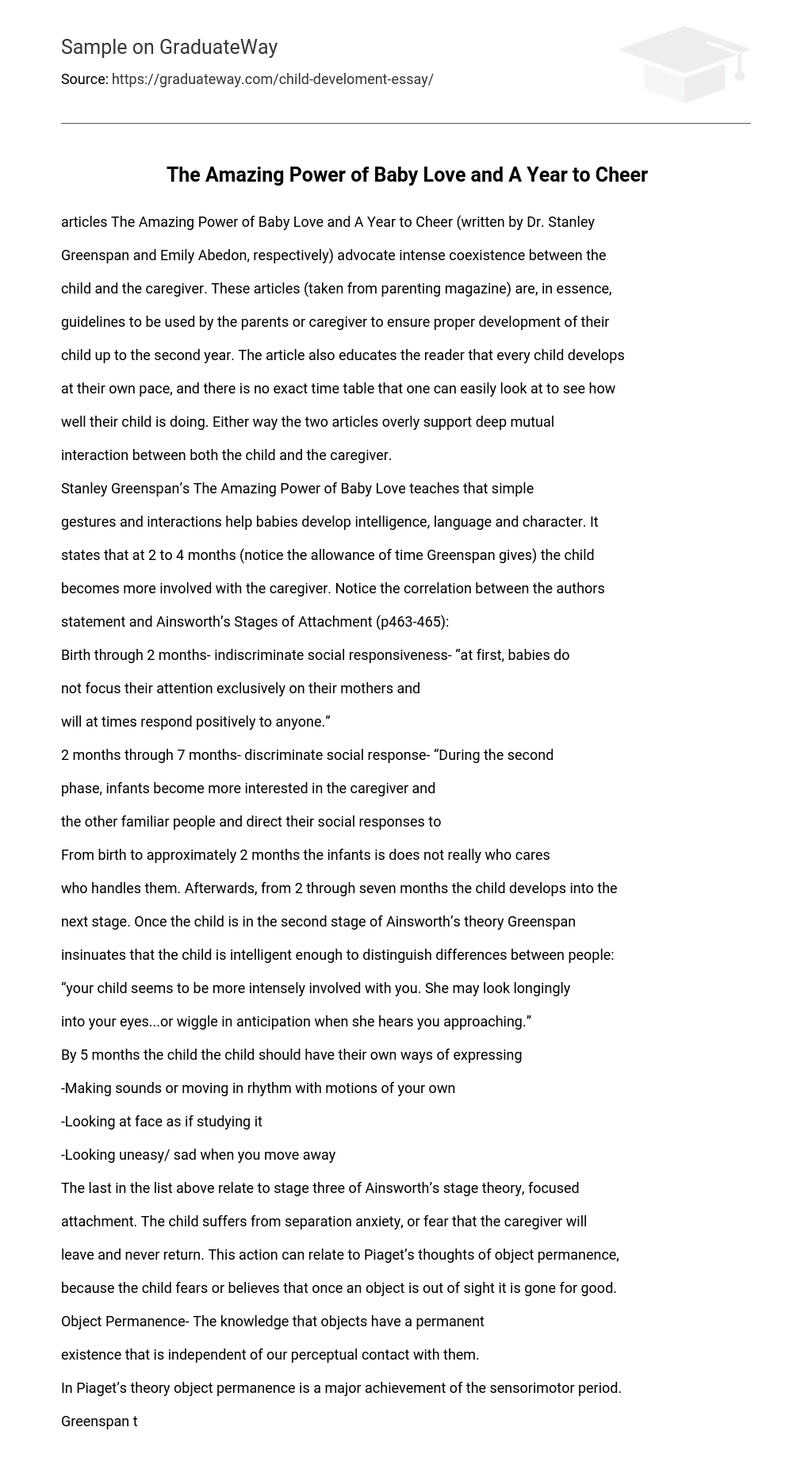Articles The Amazing Power of Baby Love and A Year to Cheer (written by Dr. Stanley Greenspan and Emily Abedon, respectively) advocate intense coexistence between the child and the caregiver. These articles (taken from parenting magazine) are, in essence, guidelines to be used by the parents or caregiver to ensure proper development of their child up to the second year.
The article also educates the reader that every child develops at their own pace, and there is no exact time table that one can easily look at to see how well their child is doing. Either way the two articles overly support deep mutual interaction between both the child and the caregiver.
Stanley Greenspan’s The Amazing Power of Baby Love teaches that simple gestures and interactions help babies develop intelligence, language and character. It states that at 2 to 4 months (notice the allowance of time Greenspan gives) the child becomes more involved with the caregiver.
Afterwards, from 2 through seven months the child develops into the next stage. Once the child is in the second stage of Ainsworth’s theory Greenspan insinuates that the child is intelligent enough to distinguish differences between people: “your child seems to be more intensely involved with you. She may look longingly into your eyes…or wiggle in anticipation when she hears you approaching.”
The last in the list above relate to stage three of Ainsworth’s stage theory, focused attachment. The child suffers from separation anxiety, or fear that the caregiver will leave and never return. This action can relate to Piaget’s thoughts of object permanence, because the child fears or believes that once an object is out of sight it is gone for good.
The knowledge that objects have a permanent existence that is independent of our perceptual contact with them. In Piaget’s theory object permanence is a major achievement of the sensorimotor period. Greenspan then begins to talk about the beginning of communication. He states that children really do have a comprehension of language before they say their first words. Gestures instead take place of verbal communication. At first gestures are purposeful for requests and referential communication, later for functioning as symbols to label objects, events and characteristics.
When the caregiver responds to the child the following interaction supposedly helps boost the child’s self esteem. More importantly, the child learns about others moods, and in turn learn the ability to react to them. By responding to a baby they learn that their actions have an observable impact on their environment. Two-way conversations also make the child more empathetic. Once they see that they have an impact on the caregiver they see that person as an individual, some one separate from
In the end Greenspan emphasizes again that children develop at their own pace. On top of that, they have their own response to a stimulus. Just because the react a way that a caregiver was expecting does not necessarily mean that there is anything wrong. When interacting with a child one should study how the child reacts, and then do what the child seemed to enjoy to “bring the most pleasure,” that should not be too obvious.
Finally Greenspan suggests the following:
- Talk in babble, using high to low pitches
- Use a variety of faces while babbling
- Massage the baby, telling them what your doing
- Move the babies arms and legs while talking and looking at them
- Do not exhaust the baby, stop when signs of
Emily Abedon’s A Year to Cheer discusses the development of a child from 12 through 24 months. The most important thing again is that Abedon emphasizes children develop at their own pace, and parents should not keep checking to see if their child is “lagging behind.” She gives the example of the two 15 month old where one is running and the other can just barely walk. Both of these situations are “perfectly normal.”
Parents really are not to blame for there child development. The ability to walk is a combination of many different aspects; from muscle tone, coordination, the ability to stand independently, and in general, the need/want to walk. All of these have to develop before the child can walk. These physiological necessities grow at independently of one another, including the brain. The rest of the essay is a list of the basic breakthroughs a caregiver can expect to see for 12 to 24 months.
The first thing Abedon brings up is about language. At the first year the child generally knows one or two words, but the important part is they understand dozens more. For example, if you ask a child for their teddy bear they will be able to give it to you, even though they do not say the words. As the year goes on the child starts making “protowords”, words that link sound and meaning.
The textbook states that even though this is a pretty significant parents really do not take too much consideration to these. Abedon then goes on to talk about the naming explosion. These articles are not the best to write on, but they are the only two that had somesort of information that were on the same subject.





